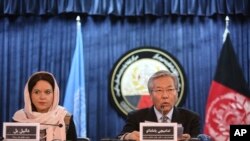The United Nations says that it has documented a staggering 54 percent increase in Afghan conflict-related deaths of women and a 17 percent rise in child fatalities during the first quarter of 2017 compared to the same period last year.
U.N. Assistance Mission in Afghanistan (UNAMA), which released the data on Thursday for overall civilian casualties, said that it was extremely concerned over the increases in both child and civilian women casualties.
The report documented a total of 715 civilian deaths since the start of the year, which included 88 women and 210 children. The hostilities injured or maimed 1,466 civilians, including 185 women and 525 children.
“With the so-called fighting season imminent, I appeal to all parties to take every measure possible to prevent unnecessary and unacceptable harm to Afghan civilians,” said UNAMA chief, Tadamichi Yamamoto.
UNAMA said children comprised 34 percent of all civilian casualties during the first quarter.
“These numbers represent the lives of 735 girls, boys and infants - 735 stories of death, maiming, physical pain, emotional trauma and grief,” said Danielle Bell, UNAMA’s Human Rights Director.
She also called on Afghanistan’s warring sides to ensure protection of children in 2017, saying the increase in child casualties reflected their failure to take adequate precautions to protect civilians.
UNAMA blamed ground fighting for being the leading cause of civilian casualties, accounting for 35 percent of all civilian casualties, followed by improvised explosive devices as well as suicide and complex attacks.
The province of Kabul had the highest number of civilian casualties “due to suicide and complex attacks” in the the Kabul city, followed by Helmand, Kandahar, Nangarhar and Uruzgan, the report noted.
It blamed Taliban-led anti-government elements for causing 62 percent of civilian casualties during the first quarter of 2017, showing a five percent increase compared to the same period last year.
UNAMA attributed 21 percent of civilian casualties to Afghan government forces, a decrease of two percent compared to the same period in 2016. But it recorded a substantial increase in civilian casualties from aerial operations.
“The mission documented 148 civilian casualties (72 dead and 76 injured) from aerial operations, a disturbing increase compared to 29 civilian casualties (eight dead and 21 injured) in the first quarter of 2016,” the report said.
A spokesman for Chief Executive Abdullah Abdullah, when asked for comments on the UNAMA report, said the government agrees with its findings that insurgents through terrorist attacks are responsible for causing most of the civilian casualties.
While the UNAMA report has documented a significant reduction in civilian casualties attributed to Afghan forces, the government is working on recommendation by the international mission to further improve the situation, spokesman Mujibur Rahman Rahimi told VOA.
UNAMA began documenting civilian casualties in 2009 and has since recorded nearly 25,000 deaths of Afghan civilians.







